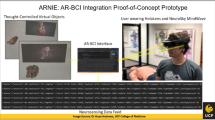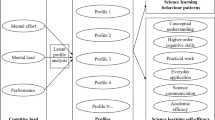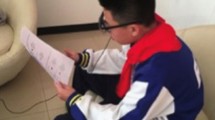Abstract
This study aims to explore the impact of an augmented reality (AR) scientific inquiry tool based on a brain-computer interface (BCI) on students’ scientific performance, flow experience, self-efficacy, and cognitive load of primary school students. The BCI-based AR inquiring tool provides real-time attention feedback to students’ activities in an AR science learning environment. Before the formal experiment, a pilot study was conducted to prove that the attention estimation algorithm involved in the tool is effective and the AR learning environment based on the BCI technology is feasible. In the formal study, quantitative and qualitative data were analyzed. A total of 41 primary school students were randomly assigned to the experimental group (EG) or the control group (CG) to learn the lever principle. The students of EG used the BCI-based AR inquiring tool, and the CG used simple AR inquiring tools without real-time attention feedback. Results show that the BCI-based AR inquiring tool positively impacts students’ scientific inquiry. It significantly helps students improve their science learning performance, achieve mental flow, and promote their scientific inquiry participation self-efficacy. Besides, no significant effect on cognitive load was found. The interview results indicate that students have a positive attitude toward the BCI-based AR scientific inquiry tool.







Similar content being viewed by others
Data Availability
The data that support the findings of this study are available from the corresponding author upon request.
References
Abd-El-Khalick, F., Boujaoude, S., Duschl, R., Lederman, N. G., Mamlok-Naaman, R., Hofstein, A., Niaz, M., Treagust, D., & Tuan, H. I. (2004). Inquiry in science education: International perspectives. Science Education, 88(3), 397–419.
Akcayir, M., Akcayir, G., Pektas, H. M., & Ocak, M. A. (2016). Augmented reality in science laboratories: The effects of augmented reality on university students’ laboratory skills and attitudes toward science laboratories. Computers in Human Behavior, 57, 334–342.
Appleton, J. J., Christenson, S. L., Kim, D., & Reschly, A. L. (2006). Measuring cognitive and psychological engagement: Validation of the student engagement instrument. Journal of School Psychology, 44(5), 427–445.
Arici, F., Yildirim, P., Caliklar, S., & Yilmaz, R. M. (2019). Research trends in the use of augmented reality in science education: Content and bibliometric mapping analysis. Computers & Education, 142, 103647.
Aveleyra, E. E., Racero, D. A., Toba, G. G., & IEEE. (2018). The didactic potential of AR in teaching physics. In 2nd IEEE World Engineering Education Conference (EDUNINE) (pp. 234–236). Univ CAECE, Buenos Aires, Argentina.
Bandura, A., Freeman, W. H., & Lightsey, R. (1997). Self-efficacy: The exercise of control. Journal of Cognitive Psychotherapy, 13(2), 158–166.
Bano, M., Zowghi, D., Kearney, M., Schuck, S., & Aubusson, P. (2018). Mobile learning for science and mathematics school education: A systematic review of empirical evidence. Computers & Education, 121, 30–58.
Bujak, K. R., Radu, I., Catrambone, R., MacIntyre, B., Zheng, R., & Golubski, G. (2013). A psychological perspective on augmented reality in the mathematics classroom. Computers & Education, 68, 536–544.
Cai, S., Liu, C., Wang, T., Liu, E., & Liang, J. C. (2021). Effects of learning physics using augmented reality on students’ self-efficacy and conceptions of learning. British Journal of Educational Technology, 52(1), 235–251.
Cai, S., Liu, E., Yang, Y., & Liang, J. -C. (2019). Tablet-based AR technology: Impacts on students’ conceptions and approaches to learning mathematics according to their self-efficacy. British Journal of Educational Technology, 50(1), 248–263.
Chang, S. -C., & Hwang, G. -J. (2018). Impacts of an augmented reality-based flipped learning guiding approach on students’ scientific project performance and perceptions. Computers & Education, 125, 226–239.
Chang, S. H. (2011). Establishment and usability evaluation of an interactive AR learning system on conservation of fish. Turkish Online Journal of Educational Technology, 10(4), 181–187.
Chen, C. -M., Wang, J. -Y., & Yu, C. -M. (2017). Assessing the attention levels of students by using a novel attention aware system based on brainwave signals. British Journal of Educational Technology, 48(2), 348–369.
Chen, C. M., & Huang, S. H. (2014). Web-based reading annotation system with an attention-based self-regulated learning mechanism for promoting reading performance. British Journal of Educational Technology, 45(5), 959–980.
Chen, C. M., & Wang, J. Y. (2017). Effects of online synchronous instruction with an attention monitoring and alarm mechanism on sustained attention and learning performance. Interactive Learning Environments, 26(4), 427–443.
Cheng, K. H., & Tsai, C. C. (2013). Affordances of augmented reality in science learning: Suggestions for future research. Journal of Science Education and Technology, 22(4), 449–462.
Davidsen, J., & Vanderlinde, R. (2014). Researchers and Teachers Learning Together and from Each Other Using Video-Based Multimodal Analysis., 45(3), 451–460.
Deeva, G., Bogdanova, D., Serral, E., Snoeck, M., & Weerdt, J. D. (2020). A review of automated feedback systems for learners: Classification framework, challenges and opportunities. Computers & Education, 162.
Dion, J. -S., & Restrepo, G. (2016). A systematic review of the literature linking neural correlates of feedback processing to learning. Zeitschrift Fur Psychologie-Journal of Psychology, 224(4), 247–256.
Engle, R. A., & Conant, F. R. (2002). Guiding principles for fostering productive disciplinary engagement: Explaining an emergent argument in a community of learners classroom. Cognition and Instruction, 20(4), 399–483.
Etin, H., & Türkan, A. (2021). The effect of augmented reality based applications on achievement and attitude towards science course in distance education process. Education Information Technologies, 1–19.
Fensham, P. J. (1988). Development and dilemmas in science education (Vol. 23). Psychology Press.
Fidan, M., & Tuncel, M. (2019). Integrating augmented reality into problem based learning: The effects on learning achievement and attitude in physics education. Computers & Education, 142, 103635.
Frey, J., Gervais, R., Fleck, S., Lotte, F., & Hachet, M. (2014). Teegi: Tangible EEG interface. In Proceedings of the 27th Annual ACM Symposium on User Interface Software and Technology (pp. 301–308).
Geeta, N., & Gavas, R. D. (2014). Enhanced learning with abacus and its analysis using BCI technology. International Journal of Modern Education Computer Science, 6(9), 22.
Gervais, R., Frey, J., Gay, A., Lotte, F., & Hachet, M. (2016). Tobe: Tangible out-of-body experience. In Proceedings of the TEI’16: Tenth International Conference on Tangible, Embedded, and Embodied Interaction (pp. 227–235).
Gyllenpalm, J. (2018). Inquiry and flow in science education. Cultural Studies of Science Education, 13(2), 429–435.
Han, P., Jen, W. G., Ling, H. M., Hung, Y. C., & Chen. (2018). Impacts of integrating the repertory grid into an augmented reality-based learning design on students’ learning achievements, cognitive load and degree of satisfaction. Interactive Learning Environments, 26(2), 221–234.
Hassan, R., Hasan, S., Hasan, M. J., Jamader, M. R., Eisenberg, D., & Pias, T. (2020). Human attention recognition with machine learning from brain-EEG signals. In 2020 IEEE 2nd Eurasia Conference on Biomedical Engineering, Healthcare and Sustainability (ECBIOS) (pp. 16–19).
Hernandez-Cuevas, B., Egbert, W., Denham, A., Mehul, A., Crawford, C. S., & Assoc Comp, M. (2020). Changing minds: Exploring brain-computer interface experiences with high school students. In the 2020 CHI Conference on Human Factors in Computing Systems (pp. 1–10). Honolulu, HI.
Ho, B., & Yim, and Poong, Hyun, & Seong. (2010). Heuristic guidelines and experimental evaluation of effective augmented-reality based instructions for maintenance in nuclear power plants. Nuclear Engineering Design, 240(12), 4096–4102.
Huang, Y.-M., Cheng, Y.-P., Cheng, S.-C., & Chen, Y.-Y. (2020). Exploring the correlation between attention and cognitive load through association rule mining by using a brainwave sensing headband. Ieee Access, 8, 38880–38891.
Hwang, G.-J., Yang, L.-H., & Wang, S.-Y. (2013). A concept map-embedded educational computer game for improving students’ learning performance in natural science courses. Computers & Education, 69, 121–130.
Ibáñez, M.-B., & Delgado-Kloos, C. (2018). Augmented reality for STEM learning: A systematic review. Computers & Education, 123, 109–123.
Ibrahim, A., Aulls, M. W., & Shore, B. M. (2016). Development, validation, and factorial comparison of the McGill Self-Efficacy of Learners For Inquiry Engagement (McSELFIE) survey in natural science disciplines. International Journal of Science Education, 38(16), 2450–2476.
İnce, R., Adanır, S. S., & Sevmez, F. (2021). The inventor of electroencephalography (EEG): Hans Berger (1873–1941). Child’s Nervous System, 37(9), 2723–2724.
Jackson, S. A., Eklund, R. C., & Martin, A. J. (2010). The flow manual: The manual for the flow scales: Mind Garden, Incorporated.
Johnstone, A. H. (1991). Why is science difficult to learn? Things are seldom what they seem. Journal of Computer Assisted Learning, 7(2), 75–83.
Jug, R., Jiang, X. S., & Bean, S. M. (2019). Giving and receiving effective feedback: A review article and how-to guide. Archives of Pathology & Laboratory Medicine, 143(2), 244–250.
Kılıç, E. (2007). The bottle neck in multimedia: Cognitive overload. Gazi University Journal of Gazi Educational Faculty, 27(2), 1–24.
Kovacevic, N., Ritter, P., Tays, W., Moreno, S., & McIntosh, A. R. (2015). ‘My virtual dream’: Collective neurofeedback in an immersive art environment. PLoS ONE, 10(7), e0130129.
Lai, A. F., Chen, C. H., & Lee, G. Y. (2019). An augmented reality-based learning approach to enhancing students’ science reading performances from the perspective of the cognitive load theory. British Journal of Educational Technology, 50(1), 232–247.
Li, Y., Li, X., Ratcliffe, M., Liu, L., Qi, Y., & Liu, Q. (2011). A real-time EEG-based BCI system for attention recognition in ubiquitous environment. In Proceedings of 2011 International Workshop on Ubiquitous Affective Awareness and Intelligent Interaction (pp. 33–40).
Lin, C.-S., Lai, Y.-C., Lin, J.-C., Wu, P.-Y., & Chang, H.-C.J. (2014). A novel method for concentration evaluation of reading behaviors with electrical activity recorded on the scalp. Computer Methods and Programs in Biomedicine, 114(2), 164–171.
Lin, F.-R., & Kao, C.-M. (2018). Mental effort detection using EEG data in E-learning contexts. Computers & Education, 122, 63–79.
Liu, C., Wu, S., Wu, S., & Cai, S. (2020). An AR-based case study of using textual and collaborative scaffolding for students with different self-efficacy to learn lever principles. In 6th International Conference of the Immersive-Learning-Research-Network (iLRN) (pp. 9–15). Electr Network.
Liu, N.-H., Chiang, C.-Y., & Chu, H.-C. (2013). Recognizing the Degree of Human Attention Using EEG Signals from Mobile Sensors., 13(8), 10273–10286.
Luft, C. D. B. (2014). Learning from feedback: The neural mechanisms of feedback processing facilitating better performance. Behavioural Brain Research, 261, 356–368.
Muris, P. (2006). Relation of attention control and school performance in normal children. Perceptual Motor Skills, 102(1), 78–80.
Nasongkhla, J., Supadaec, C., & Chiasiriphan, T. (2019). Implementing multiple AR markers in learning science content with junior high school students in Thailand. International Journal of Emerging Technologies in Learning, 14(7), 48–60.
Papanastasiou, G. P., Drigas, A., Lytras, M., & Skianis, C. (2020). Brain computer interface based applications for training and rehabilitation of students with neurodevelopmental disorders. A Literature Review. Heliyon, 6(6), e04250.
Pedaste, M., & Mitt, G. (2020). Framework for contemporary inquiry-based augmented reality learning. In 20th IEEE International Conference on Advanced Learning Technologies (ICALT) (pp. 327–328). Electr Network.
Radianti, J., Majchrzak, T. A., Fromm, J., & Wohlgenannt, I. (2020). A systematic review of immersive virtual reality applications for higher education: Design elements, lessons learned, and research agenda. Computers & Education, 147, 103778.
Ramakuri, S. K., Ghosh, S., & Gupta, B. (2017). Behaviour state analysis through brain computer interface using wearable EEG devices: A review. The International Journal of Electronic Government Research, 13(4), 377–390.
Roennebeck, S., Bernholt, S., & Ropohl, M. (2016). Searching for a common ground - A literature review of empirical research on scientific inquiry activities. Studies in Science Education, 52(2), 161–197.
Rydlinger, A. (1997). Augmented Reality. Presence, 6(2), 92–93.
Sahin, D., & Yilmaz, R. M. (2020). The effect of augmented reality technology on middle school students’ achievements and attitudes towards science education. Computers & Education, 144, 103710.
Sawangjai, P., Hompoonsup, S., Leelaarporn, P., Kongwudhikunakorn, S., & Wilaiprasitporn, T. (2019). Consumer grade EEG measuring sensors as research tools: A review. Ieee Sensors Journal, 20(8), 3996–4024.
Serrhini, M., & Dargham, A. (2016). Toward incorporating bio-signals in online education case of assessing student attention with BCI. In Europe, Middle East and North Africa Conference on Technology and Security to Support Learning (EMENA-TSSL) (Vol. 520, pp. 135–146). Oujda, MOROCCO.
Serrhini, M., & Dargham, A. (2017). Toward incorporating bio-signals in online education case of assessing student attention with BCI. In Europe and MENA Cooperation Advances in Information and Communication Technologies (pp. 135–146): Springer.
Shernoff, D. J., Csikszentmihalyi, M., Schneider, B., & Shernoff, E. S. (2014). Student engagement in high school classrooms from the perspective of flow theory. In Applications of Flow in Human Development and Education (pp. 475–494): Springer Dordrecht.
Si-Mohammed, H., Petit, J., Jeunet, C., Argelaguet, F., Spindler, F., Évain, A., Roussel, N., Casiez, G., & Lecuyer, A. (2020). Towards BCI-based interfaces for augmented reality: Feasibility, design and evaluation. Ieee Transactions on Visualization and Computer Graphics, 26(3), 1608–1621.
Sirakaya, M., Kilic Cakmak, E., & training. (2018). Effects of augmented reality on student achievement and self-efficacy in vocational education and training. International Journal for Research in Vocational Education, 5(1), 1–18.
Sun, J.C.-Y., & Yeh, K.P.-C. (2017). The effects of attention monitoring with EEG biofeedback on university students’ attention and self-efficacy: The case of anti-phishing instructional materials. Computers & Education, 106, 73–82.
Turan, Z., & Atila, G. (2021). Augmented reality technology in science education for students with specific learning difficulties: Its effect on students’ learning and views. Research in Science & Technological Education, 39(4), 1–19.
Velázquez, F., & Méndez, G. (2021). Application in augmented reality for learning mathematical functions: A study for the development of spatial intelligence in secondary education students. Mathematics, 9(4), 369.
Verkijika, S. F., & De Wet, L. (2015). Using a brain-computer interface (BCI) in reducing math anxiety: Evidence from South Africa. Computers & Education, 81, 113–122.
Vickers, P. (2011). Sonification for process monitoring. The Sonification Handbook, 455–492.
Wang, M., Zhang, S., Lv, Y., & Lu, H. (2018). Anxiety level detection using BCI of miner’s smart helmet. Mobile Networks & Applications, 23(2), 336–343.
Wegemer, C. (2019). Brain-computer interfaces and education: The state of technology and imperatives for the future. International Journal of Learning Technology, 14(2), 141–161.
Wei, X., Weng, D., Liu, Y., & Wang, Y. (2015). Teaching based on augmented reality for a technical creative design course. Computers & Education, 81, 221–234.
Whalen, S. P. (1999). Finding flow at school and at home: A conversation with Mihaly Csikszentmihalyi. Journal of Secondary Gifted Education, 10(4), 161–165.
Whitson, C., & Consoli, J. (2009). Flow theory and student engagement. Journal of Cross-Disciplinary Perspectives in Education, 2(1), 40–49.
Wolpaw, J. R., Birbaumer, N., Heetderks, W. J., McFarland, D. J., Peckham, P. H., Schalk, G., Donchin, E., Quatrano, L. A., Robinson, C. J., & Vaughan, T. M. (2000). Brain-computer interface technology: A review of the first international meeting. IEEE Transactions on Rehabilitation Engineering, 8(2), 164–173.
Wu, P.-H., & Wu, H.-K. (2020). Constructing a model of engagement in scientific inquiry: Investigating relationships between inquiry-related curiosity, dimensions of engagement, and inquiry abilities. Instructional Science, 48(1), 79–113.
Yang, C., Ye, Y., Li, X., & Wang, R. (2018). Development of a neuro-feedback game based on motor imagery EEG. Multimedia Tools and Applications, 77(12), 15929–15949.
Yoon, H.-G., Joung, Y. J., & Kim, M. (2012). The challenges of science inquiry teaching for pre-service teachers in elementary classrooms: Difficulties on and under the scene. Research in Science Education, 42(3), 589–608.
Yoon, S. A., Anderson, E., Park, M., Elinich, K., & Lin, J. (2018). How augmented reality, textual, and collaborative scaffolds work synergistically to improve learning in a science museum. Research in Science & Technological Education, 36(3), 261–281.
Yu, S. J., Sun, J. C. Y., & Chen, O. T. C. (2019). Effect of AR-based online wearable guides on university students’ situational interest and learning performance. Universal Access in the Information Society, 18(2), 287–299.
Zhang, S., & Jiang, J. (2018). The research and prospect on the application of augmented reality in science education. e-Education Research, 39(7), 64–69.
Zhang, S. F., & Jiang, J. F. (2017). Application of augmented reality in chemistry teaching and enlightenments. Chinese Journal of Chemical Education, 38(21), 43–49.
Zimmerman, H. T., Land, S. M., McClain, L. R., Mohney, M. R., Choi, G. W., & Salman, F. H. (2015). Tree investigators: Supporting families’ scientific talk in an arboretum with mobile computers. International Journal of Science Education, 5(1), 44–67.
Funding
This research was funded by the National Natural Science Foundation of China (61977007).
Author information
Authors and Affiliations
Contributions
All authors contributed to the study conception and design. Material preparation, data collection, and analysis were performed by Su Cai, Zifeng Liu, and Changhao Liu. The first draft of the manuscript was written by Zifeng Liu, Haitao Zhou, and Jiangxu Li, and all authors revised and commented on previous versions of the manuscript. All authors read and approved the final manuscript.
Corresponding author
Ethics declarations
Ethics Approval
All procedures performed in studies involving human participants were in accordance with the ethical standards of the Research Ethics Review Committee of Faculty of Education, Beijing Normal University.
Informed Consent
Informed consent was obtained from all individual participants included in the study. Students volunteered to participate in this study, and the data was reported anonymously by researchers.
Conflict of Interest
The authors declare no competing interests.
Additional information
Publisher's Note
Springer Nature remains neutral with regard to jurisdictional claims in published maps and institutional affiliations.
Rights and permissions
Springer Nature or its licensor holds exclusive rights to this article under a publishing agreement with the author(s) or other rightsholder(s); author self-archiving of the accepted manuscript version of this article is solely governed by the terms of such publishing agreement and applicable law.
About this article
Cite this article
Cai, S., Liu, Z., Liu, C. et al. Effects of a BCI-Based AR Inquiring Tool on Primary Students’ Science Learning: A Quasi-Experimental Field Study. J Sci Educ Technol 31, 767–782 (2022). https://doi.org/10.1007/s10956-022-09991-y
Accepted:
Published:
Issue Date:
DOI: https://doi.org/10.1007/s10956-022-09991-y




